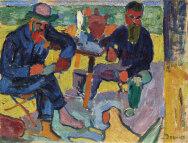An unknown masterpiece by the French painter André Derain (1880- 1954) depicting the artists Henri Matisse and Etienne Terrus, painted in 1905, was sold today at auction at Christie’s in Paris for 3.2 million euros. For almost 120 years the oil on canvas was part of the family collection of the Catalan painter Etienne Terrus, who hosted Derain and Matisse in Collioure in the summer of 1905. The painting “Matisse and Terrus” symbolizes the friendship between these three figures founders of Fauvism. Most likely given to Terrus shortly after 1905, this work celebrates the camaraderie between Matisse, Derain and Terrus and the genesis of Fauvism in the picturesque setting of the quaint fishing port of Collioure and its surroundings.
In 1905, in this village on the border with Spain, the two pioneers of the Parisian avant-garde spent the summer, immersed in the unique brightness of the south, surrounded by new acquaintances, including Etienne Terrus. During this time André Derain created several vibrant works inspired by the location. Unlike Matisse, Derain never returned to Collioure and transformed this unique stay into a crucial moment in his career, marking the birth of a revolutionary style, the premise of modern art.
“Matisse and Terrus” has a particular meaning in Derain’s work in Collioure, not only for the representation of tripartite friendship. A few months later, at the 1905 Paris Salon d’Automne, his bold style and lively Fauvist palette were described as “an orgy of pure tones”, officially giving birth to one of the major modern art movements. Sitting quietly on a seaside terrace, probably overlooking Racou beach, near Argelès-sur-Mer, Matisse and Terrus exude a relaxed air. Matisse, with his distinctive red beard, is depicted on the left smoking a pipe, while Terrus looks thoughtfully into the distance on the right.
Captured by light and color, Derain gradually abandons lines and separates color from its descriptive and representational purpose, allowing it to exist on the canvas as an independent and focal element. These thick, broad brushstrokes of pure pigment, full of sensual vitality, embody the turn towards modernity.
